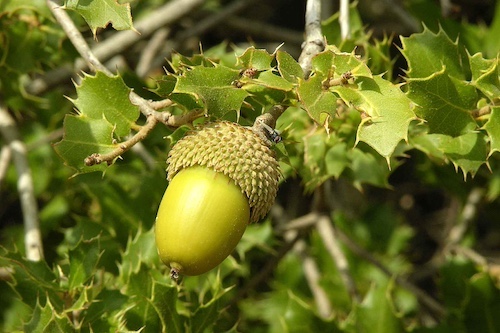(Kermes oak)
The eleventh month of the year has started and still not a drop of rain has fallen on the Eastern Greek islands to which Lesvos belongs. Even though autumn has softly pushed the summer away, the clouds remain elsewhere so that swimmers and other beachgoers can still enjoy the sea and the sun. But the trees have started to colour and below them the ground is crunching with their fallen leaves.
The time to gather winter food supplies is in full swing. For weeks already I have watched the well organized ants labour with grains of corn and other edible crumbs. These little bullies have finally left the house to concentrate on the making ready of their subterranean housing system outside, where they will retreat during winter.
Field mice run through the dry fields and squirrels jump through the trees looking for nuts and seeds. I didn’t know that some ‘babbling birds’ also make winter supplies: Eurasian jays (Garrulus glandarius). These racketing birds can produce lots of noise, so much that sometimes you would consider calling the police because of noise pollution. But they actually take on the role of police officers themselves by screaming loudly to warn other animals in the wood of approaching danger. They are also masters at imitating other birds and as such sometimes hooded crows, who then are falsely accused of making all the agitation. Hawks and buzzards are also in their singing repertoire.
Before winter starts each jay has to gather 15 kilo of acorns or other nuts and he has to hide it, which means burying some 4000 nuts. I now realise why those acorn searchers were so busy in the field and under the olive trees. In theory they can remember some 6000 hiding places, but each year they forget some, giving them the nickname of ‘wood builders’ since those lost nuts can develop roots and become a new tree.
Acorns are their favourite food and Lesvos has plenty of acorns. There are some seven different species of acorn trees on the island for the jays to enjoy (turkey oak, kermes oak, valonia oak, pubescent oak, evergreen oak, Hungarian oak and Aleppo oak). Not that long ago acorns were used on Lesvos in the tanneries but since they no longer operate the animals have them all for themselves.
There were times when people collected supplies for winter; cool, dark cellars and supply pantries were filled up with potatoes and other fruit that needed to be kept for winter. However, since we now have supermarkets people have forgotten that there are a thousand ways to preserve food.
But whoever loves to build up a winter supply must also love Lesvos. Even though in Greece the number of people who can live a winter without too many visits to the supermarket recedes; on Lesvos a few remain, mostly women, who preserve and gather from the fields and in nature: the autumn chestnuts, nuts, apples, quinces and pomegranates. Figs are dried or made into fig cakes, grapes will be turned into wine or tsipouro and there are also the olives, that are preserved with salt or vinegar, but mostly they are harvested for the oil.
Three years ago the island counted 83,755 inhabitants and some 11 million olive trees. That is per islander some 131 trees. It is unknown how many other fruit trees are spread over the island, but probably even a few more per inhabitant. When in autumn you wander over the island, you may stumble over plenty of fallen fruit, not harvested, because most people now feel more at home in the supermarket than under the trees. The chestnut woods above Agiasos could provide all inhabitants of the island with chestnuts, but people will eat at most a handful of roasted chestnuts at the chestnut festival of this mountain village of Agiasos. Peeling chestnuts is a hell of a job and, just like preserving other fruits, a time consuming job.
Jays do not lose time preserving food, but they also do not visit shops. They have to survive the winter with nuts. People have a broader diet. But lots of them do not know that homemade jam, pickles or dried tomatoes are all much more tasty than anything from the shops. Nor can you find in supermarkets fig cakes, quince jelly or chestnut soup.











